
Iowa City is the county seat and largest city of Johnson County, Iowa, United States. It is the home of the University of Iowa and county seat of Johnson County, at the center of the Iowa City Metropolitan Statistical Area. At the time of the 2020 census the population was 74,828, making it the state's fifth-most populous city. The metropolitan area, which encompasses Johnson and Washington counties, has a population of over 171,000. The Iowa City Metropolitan Statistical Area (MSA) is also a part of a Combined Statistical Area (CSA) with the Cedar Rapids MSA. This CSA plus two additional counties are known as the Iowa City-Cedar Rapids region which collectively has a population of nearly 500,000.
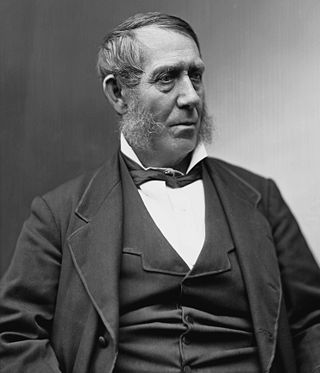
Samuel Jordan Kirkwood was an American politician who twice served as governor of Iowa, twice as a U.S. Senator from Iowa, and as the U.S. Secretary of the Interior.

Carson Pass is a mountain pass on the crest of the central Sierra Nevada, in the Eldorado National Forest and Alpine County, eastern California.

Spring Grove Cemetery and Arboretum is a nonprofit rural cemetery and arboretum located at 4521 Spring Grove Avenue, Cincinnati, Ohio. It is the third largest cemetery in the United States, after the Calverton National Cemetery and Abraham Lincoln National Cemetery and is recognized as a US National Historic Landmark.
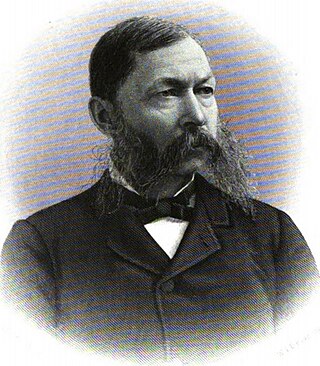
Moses Wheelock Field was a businessman and politician. He served as a member of the United States House of Representatives from the U.S. state of Michigan, and was instrumental in organizing the Independent Greenback Party.
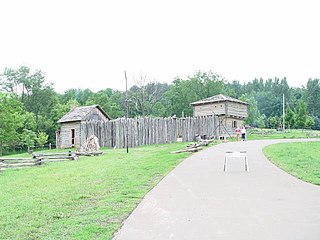
The Battle of Apple River Fort, occurred on the late afternoon of June 24, 1832 at the Apple River Fort, near present-day Elizabeth, Illinois, when Black Hawk and 200 of his "British Band" of Sauk and Fox were surprised by a group of four messengers en route from Galena, Illinois. One of the couriers was wounded in the thigh as the riders quickly made for the protection of the nearby stockade. Courier Fred Dixon lagged behind and provided cover for his comrades. The other couriers rode ahead to warn some 70 settlers of the approaching Sauk and Fox, thus saving their lives. The small company of militia at the fort, about 28-30 men and boys led by Captain Clack Stone, fought off Black Hawk's 150-man war party in an action that lasted about an hour. The withering pace of the gunfire eventually convinced Black Hawk that the fort was too heavily defended to lead a direct attack. He considered burning the fort, then switched to raiding cabins of foodstuffs, clothing and cooking utensils. In the gathering darkness, Black Hawk and his war party retreated.
The Sinsinawa Mound raid occurred on June 29, 1832, near the Sinsinawa mining settlement in Michigan Territory. This incident, part of the Black Hawk War, resulted in the deaths of two men; a third man survived by seeking cover in a nearby blockhouse. In the aftermath of the raid, Captain James W. Stephenson set out to pursue the attackers—a straggling band of Sauk Native Americans—but lost their trail at the Mississippi River. The attack occurred in the same week as other skirmishes and raids, and as a result helped contribute to the growing fear in the region. The raid caused the residents of nearby Platteville to consider fleeing their settlement.

Robert Lucas was the 12th governor of Ohio, serving from 1832 to 1836. He also served as the first governor of the Iowa Territory from 1838 to 1841.

Eleanor Hoyt Brainerd was an early 20th-century American writer. She published at least 10 novels, mostly written for young women.

The archaeology of Iowa is the study of the buried remains of human culture within the U.S. state of Iowa from the earliest prehistoric through the late historic periods. When the American Indians first arrived in what is now Iowa more than 13,000 years ago, they were hunters and gatherers living in a Pleistocene glacial landscape. By the time European explorers visited Iowa, American Indians were largely settled farmers with complex economic, social, and political systems. This transformation happened gradually. During the Archaic period American Indians adapted to local environments and ecosystems, slowly becoming more sedentary as populations increased. More than 3,000 years ago, during the Late Archaic period, American Indians in Iowa began utilizing domesticated plants. The subsequent Woodland period saw an increase on the reliance on agriculture and social complexity, with increased use of mounds, ceramics, and specialized subsistence. During the Late Prehistoric period increased use of maize and social changes led to social flourishing and nucleated settlements. The arrival of European trade goods and diseases in the Protohistoric period led to dramatic population shifts and economic and social upheaval, with the arrival of new tribes and early European explorers and traders. During the Historical period European traders and American Indians in Iowa gave way to American settlers and Iowa was transformed into an agricultural state.
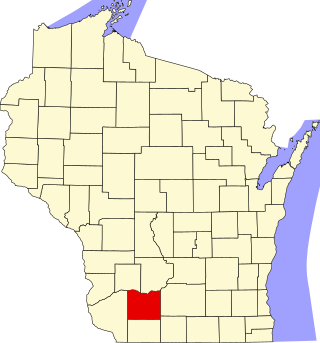
This is a list of the National Register of Historic Places listings in Iowa County, Wisconsin. It is intended to provide a comprehensive listing of entries in the National Register of Historic Places that are located in Iowa County, Wisconsin. The locations of National Register properties for which the latitude and longitude coordinates are included below may be seen in a map.
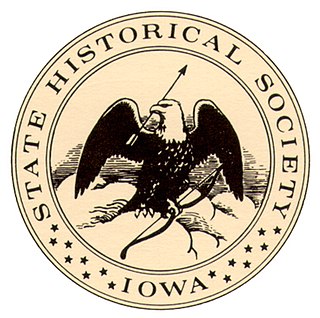
The State Historical Society of Iowa (SHSI), a division of the Iowa Department of Cultural Affairs, serves as the official historical repository for the State of Iowa and also provides grants, public education, and outreach about Iowa history and archaeology. The SHSI maintains a museum, library, archives, and research center in Des Moines and a research library in Iowa City, as well as several historic sites in Iowa. It was founded in 1857 in Iowa City, where it was first affiliated with the University of Iowa. As the organization grew in size and collections, it became a separate state agency headquartered near the Iowa Capitol in Des Moines.

Fort Atkinson State Preserve is a state preserve of Iowa, USA, containing the remnants of Fort Atkinson, a U.S. Army frontier post created to keep the peace between various Native American tribes as well as prevent white settlers from encroaching on Indian lands. In February 2013 the fort was listed on the National Register of Historic Places as Fort Atkinson Historic District.
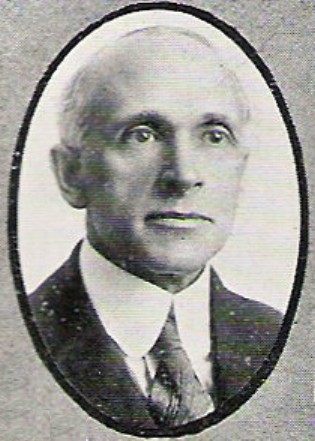
Charles Reuben Keyes was a pioneering American archaeologist and linguist based in Iowa, known as the founder of modern Iowa archaeology. He is, with Ellison Orr (1857-1951), considered a key person to gaining protection for the Effigy Mounds National Monument, established by Congress in 1949 to protect hundreds of prehistoric earthworks built by indigenous Native American cultures.
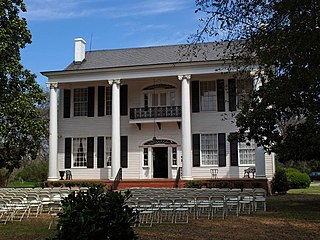
The Montgomery–Janes–Whittaker House, best known today as Buena Vista, is a historic Federal style plantation house in Autauga County, Alabama, south of Prattville. It was listed on the National Register of Historic Places on October 25, 1974. The house is currently owned by the Autauga County Heritage Association and operated as a historic house museum.
The Great Flood of 1851 occurred after record-setting rainfalls across the Midwestern United States and Plains from May to August, 1851. Hardest hit was the State of Iowa, with significant flooding extending to the Lower Mississippi River basin. Historical evidence suggest flooding occurred in the eastern Plains, from Nebraska to the Red River basin, but these areas were sparsely settled in 1851. Heavy rainfall also occurred in the Ohio River basin.

Brainerd is an unincorporated community in Butler County, Kansas, United States. It is located on the north side of K-196 highway between the cities of Whitewater and Potwin.
St. Columba Mission was an Ojibwe community on Gull Lake in Crow Wing County, Minnesota, United States, about 11 miles (18 km) north of Fort Ripley. It centered on the first Native American Christian church in the United States west of the Mississippi River, founded in 1852 by the Episcopal missionary James Lloyd Breck and Enmegahbowh, who served as deacon. The squared log church was consecrated in 1853 by Bishop Jackson Kemper.

Plum Grove is a ghost town in Butler County, Kansas, United States. It was located in a rural area north of modern-day Potwin. No buildings remain at this former community site.

Daniel Nelson House and Barn, also known as the Nelson Pioneer Farm and Museum, are historic buildings located north of Oskaloosa, Iowa, United States. Daniel and Margaret Nelson settled here in 1844, a year after this part of Iowa was opened to settlement by the U.S. Government. Their first home was a log structure, non-extant, located northeast of the present house. The present house is a two-story, brick structure with a gable roof. The wooden porches on the front and back of the house date from 1898 to 1900. The large barn measures 61 by 46 feet, and was built in 1856. It is composed of board and batten construction from oak that was milled on the site. It was used largely as a granary, rather than a shelter for farm animals. Three other buildings included in the historic designation include the summer kitchen, woodshed, and a small outdoor privy. The dates of construction for the three frame buildings is unknown. The farm remained in the Nelson family until 1941 when it was abandoned with most of the original furnishings intact. The property was donated to the Mahaska County Historical Society, which now operates it as a museum. Other historic buildings have been moved to this location over the years. It was listed on the National Register of Historic Places in 1974.




















